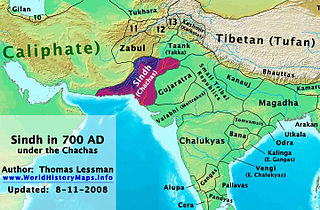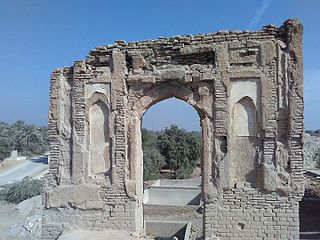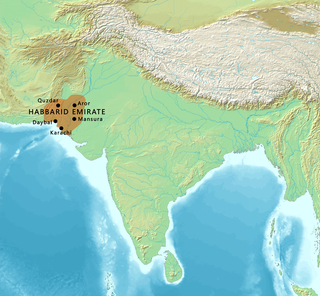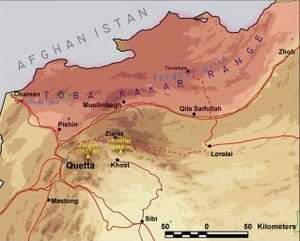
Muḥammad ibn al-Qāsim al-Thaqafī was an Arab military commander in service of the Umayyad Caliphate who led the Muslim conquest of Sindh, inaugurating the Umayyad campaigns in India. His military exploits led to the establishment of the Islamic province of Sindh, and the takeover of the region from the Sindhi Brahman dynasty and its ruler, Raja Dahir, who was subsequently decapitated with his head sent to al-Hajjaj ibn Yusuf in Basra. With the capture of the then-capital of Aror by Arab forces, Muhammad ibn al-Qasim became the first Muslim to have successfully captured Indian land, which marked the beginning of Muslim rule in South Asia.
Atiyah ibn Sa'd ibn Junādah al‐'Awfi [died 729] was an early Muslim scholar of Islam. He is regarded as a reliable narrator of hadith. An aged supporter of rebels and a Shia notable of the time, a disciple of the companion of Muhammad Jabir ibn Abd Allah al-Ansari and a famous narrator of Hadith, Atiyya ibn Sa'd Awfi was arrested by Muhammad bin Qasim on the orders of Al-Hajjaj and demanded that he curse Ali on the threat of punishment. Atiyya refused to curse Ali and was punished. While Maclean doesn't give the details of the punishment, early historians like Ibn Hajar Al-asqalani and Tabari record that he was flogged by 400 lashes and his head and beard shaved for humiliation and that he fled to Khurasan and returned to Iraq after the ruler had been changed.

The Muslim conquests in the Indian subcontinent mainly took place between the 13th and the 18th centuries. Earlier Muslim conquests in the subcontinent include the invasions which started in the northwestern subcontinent, especially the Umayyad campaigns during the 8th century. Mahmud of Ghazni, Sultan of the Ghaznavid Empire, preserved an ideological link to the suzerainty of the Abbasid Caliphate and invaded vast parts of Punjab and Gujarat during the 11th century. After the capture of Lahore and the end of the Ghaznavids, the Ghurid ruler Muhammad of Ghor laid the foundation of Muslim rule in India in 1192. In 1202, Bakhtiyar Khalji led the Muslim conquest of Bengal, marking the easternmost expansion of Islam at the time.
Chach Nama, also known as the Fateh nama Sindh, and as Tareekh al-Hind wa a's-Sind, is one of the historical sources for the history of Sindh and it was written in 13th century by Ali Kufi.
Raja Dahir was the last Hindu ruler of Sindh. A Brahmin ruler, his kingdom was invaded in 711 CE by the Arab Umayyad Caliphate, led by Muhammad bin Qasim, where Dahir died while defending his kingdom. According to the Chachnama, the Umayyad campaign against Dahir was due to a pirate raid off the coast of the Sindhi coast that resulted in gifts to the Umayyad caliph from the king of Serendib being stolen.
Samma is a community called Sammat and a tribe that has origins in Sindh. The Samma are spread across Pakistan and North-West India. The Sandhai Muslims are Samma who converted to Islam. Offshoots of the main branch of Samma include the Jadejas and Chudasamas of India.

The history of Sindh refers to the history of the Pakistani province of Sindh, as well as neighboring regions that periodically came under its sway.

The Umayyad Dynasty came to rule the Caliphate in 661 CE, and during the first half of the 8th century CE, a series of battles took place in the Indian subcontinent between armies of the Umayyad Caliphate and Indian kingdoms situated to the east of the Indus river, subsequent to the Arab conquest of Sindh in present-day Pakistan during 711 – 713 CE.

Aror or Alor or Arorkot is the medieval name of the city of Rohri. Aror once served as the capital of Sindh.

The Battle of Rasil was fought between the Rashidun Caliphate and the Rai kingdom ruled by Raja Rasil in early 644. It was the first encounter of the Rashidun Caliphate in the Indian subcontinent. The exact location of the battle is not known, but historians suggest it was fought on the western bank of the River Indus.

The Habbari were an Arab dynasty that ruled much of Greater Sindh, as a semi-independent emirate from 854 to 1024. Beginning with the rule of 'Umar bin Abdul Aziz al-Habbari in 854 CE, the region became semi-independent from the Abbasid Caliphate in 861, while continuing to nominally pledge allegiance to the Abbasid Caliph in Baghdad. The Habbari ascension marked the end of a period of direct rule of Sindh by the Umayyad and Abbasid Caliphates, which had begun in 711 CE.

Mansura, referred to as Brahmanabad in later centuries, was the historic capital of the caliphal province of Sindh, during the eighth century under the Umayyad Caliphate and then Abbasid Caliphate from the year 750 AD to 1006 AD. The city was founded as a central garrison by the Umayyad Forces in Sindh, the city transformed into a very vibrant metropolis during the Abbasid Era surpassing the wealth of Multan in the north and Debal in the south. Mansura was the first capital established by the Muslims in the Indian subcontinent after Muhammad bin Qasim seized the Brahmanabad territory. Mansura was built on the shores of the Indus River, it was surrounded by fertile farmland, Ibn Hauqal mentioned the wealthy local merchants who wore Baghdad Costume and were of Sindhi-Arab origins, houses were made of clay, baked bricks and plaster.
Sind was an administrative division of the Umayyad Caliphate and later of the Abbasid Caliphate in post-classical India, from around 711 CE with the Umayyad conquest of Sindh by the Arab military commander Muhammad ibn al-Qasim, to around 854 CE with the emergence of the independent dynasties of the Habbarid Emirate and the Emirate of Multan. The "Governor of Sind" was an official who administered the caliphal province over what are now Sindh and South Punjab in Pakistan, with Makran in Balochistan also usually being under his control.

The Brahmin dynasty of Sindh, also known as the Chacha dynasty, was the ruling dynasty of the Sindh, succeeding the Rai dynasty. Most of the information about its existence comes from the Chach Nama, a historical account of the Chach-Brahmin dynasty.

The Arab conquest of Kaikan was a military campaign by the Rashidun and Umayyad Caliphates aganist the Jats of Kaikan, in present-day Pakistan. The Kingdom of Kaikan faced several invasions from the caliphate. During the reign of the Khalifa Al-Mutasim, the Arabs annexed this region successfully after defeating the Jats.
Surya Devi, was an Indian Hindu Princess of Sind. She is known for having been the war booty of the Umayyad army commander Muhammad bin Qasim during the Umayyad conquest of Sindh and given along with her sister as slaves to Caliph Sulayman ibn Abd al-Malik. According to the traditional story, she persuaded the Caliph to execute Muhammad bin Qasim, avenging her parents, and then managed to eskape the captivity of the harem by having the Calph execute her and her sister.
The Sindhi Jats are the Sindhi community, who are the indigenous population of Sindh.

The Battle of Aror, also known as the Battle of Rewar, took place in 711 AD between the Umayyad forces under Muhammad ibn al-Qasim and the army of Brahmin dynasty of Sindh under Raja Dahir. It was the last military conflict of Raja Dahir, in which the Umayyads defeated his army near Indus river and resulted in the death of Dahir.
Zuṭṭ is an Arabicised form of Jat. Originally inhabitants of lower Indus Valley, Jats were present in Mesopotamia since as early as 5th century AD, although their main migration occurred after the establishment of Umayyad Caliphate. They were one of the prominent ethnic groups in lower Iraq during Islamic Golden Age, supplying mercenary soldiers to the Muslim states. Their mention fades from Arab chronicles after 11th century.
Sindhi Rajputs are one of the indigenous community of Sindhi people, they are mostly Muslim and Hindu Sindhis. They are found throughout Sindh, as well as in its neighboring regions like Balochistan, South Punjab, Rajasthan and Gujarat.











